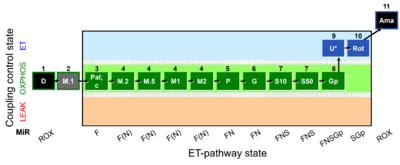| Step
|
State
|
Pathway
|
Q-junction
|
Comment - Events (E) and Marks (M)
|
| 1D
|
ROX
|
|
|
1D
- ADP is added to stimulate the consumption of endogenous fuel-substrates.
|
| 2M.1
|
|
|
|
1D;2M.1
|
| 3Pal
|
PalMP
|
F
|
FAO
|
1D;2M.1;3Pal
- Respiratory stimulation of the FAO-pathway, F, by fatty acid, FA, in the presence of malate, M. Malate is a type N substrate (N), required for the F-pathway. The FA concentration has to be optimized to saturate the F-pathway, without inhibiting or uncoupling respiration.
|
| 3c
|
PalMcP
|
F
|
FAO
|
1D;2M.1;3Pal;3c
- Respiratory stimulation of the FAO-pathway, F, by fatty acid, FA, in the presence of malate, M. Malate is a type N substrate (N), required for the F-pathway. The FA concentration has to be optimized to saturate the F-pathway, without inhibiting or uncoupling respiration.
- OXPHOS capacity P (with saturating [ADP]), active OXPHOS state.
- Addition of cytochrome c yields a test for integrity of the mtOM (cytochrome c control efficiency). Stimulation by added cytochrome c would indicate an injury of the mtOM and limitation of respiration in the preceding state without added c due to loss of cytochrome c. Typically, cytochrome c is added immediately after the earliest ADP-activation step (OXPHOS capacity P with saturating [ADP]).
|
| 4M.2
|
PalMP
|
F(N)
|
FAO
|
1D;2M.1;3Pal;3c;4M.2
- Respiratory stimulation of the FAO-pathway, F, by fatty acid FA in the presence of malate M. Malate is a type N substrate (N), required for the F-pathway. In the presence of anaplerotic pathways (e.g., mitochondrial malic enzyme, mtME) the F-pathway capacity is overestimated, if there is an added contribution of NADH-linked respiration, F(N) (see SUIT-002). The FA concentration has to be optimized to saturate the FAO-pathway, without inhibiting or uncoupling respiration.
- Malate kinetics in the presence of saturating [ADP] allows the evaluation of malate anaplerotic pathways.
- OXPHOS capacity P (with saturating [ADP]), active OXPHOS state.
|
| 4M.5
|
PalMP
|
F(N)
|
FAO
|
1D;2M.1;3Pal;3c;4M.2;4M.5
- Respiratory stimulation of the FAO-pathway, F, by fatty acid FA in the presence of malate M. Malate is a type N substrate (N), required for the F-pathway. In the presence of anaplerotic pathways (e.g., mitochondrial malic enzyme, mtME) the F-pathway capacity is overestimated, if there is an added contribution of NADH-linked respiration, F(N) (see SUIT-002). The FA concentration has to be optimized to saturate the FAO-pathway, without inhibiting or uncoupling respiration.
- Malate kinetics in the presence of saturating [ADP] allows the evaluation of malate anaplerotic pathways.
- OXPHOS capacity P (with saturating [ADP]), active OXPHOS state.
|
| 4M1
|
PalMP
|
F(N)
|
FAO
|
1D;2M.1;3Pal;3c;4M.2;4M.5;4M1
- Respiratory stimulation of the FAO-pathway, F, by fatty acid FA in the presence of malate M. Malate is a type N substrate (N), required for the F-pathway. In the presence of anaplerotic pathways (e.g., mitochondrial malic enzyme, mtME) the F-pathway capacity is overestimated, if there is an added contribution of NADH-linked respiration, F(N) (see SUIT-002). The FA concentration has to be optimized to saturate the FAO-pathway, without inhibiting or uncoupling respiration.
- Malate kinetics in the presence of saturating [ADP] allows the evaluation of malate anaplerotic pathways.
- OXPHOS capacity P (with saturating [ADP]), active OXPHOS state.
|
| 4M2
|
PalMP
|
F(N)
|
FAO
|
1D;2M.1;3Pal;3c;4M.2;4M.5;4M1;4M2
- Respiratory stimulation of the FAO-pathway, F, by fatty acid FA in the presence of malate M. Malate is a type N substrate (N), required for the F-pathway. In the presence of anaplerotic pathways (e.g., mitochondrial malic enzyme, mtME) the F-pathway capacity is overestimated, if there is an added contribution of NADH-linked respiration, F(N) (see SUIT-002). The FA concentration has to be optimized to saturate the FAO-pathway, without inhibiting or uncoupling respiration.
- Malate kinetics in the presence of saturating [ADP] allows the evaluation of malate anaplerotic pathways.
- High concentration of malate, typically 2 mM, saturates the N-pathway.
- OXPHOS capacity P (with saturating [ADP]), active OXPHOS state.
|
| 5P
|
PalPMP
|
FN
|
FAO&CI
|
1D;2M.1;3Pal;3c;4M.2;4M.5;4M1;4M2;5P
- Respiratory stimulation by simultaneous action of the F-pathway and N-pathway with convergent electron flow in the FN-pathway for evaluation of an additive or inhibitory effect of F.
- OXPHOS capacity P (with saturating [ADP]), active OXPHOS state.
|
| 6G
|
PalPGMP
|
FN
|
FAO&CI
|
1D;2M.1;3Pal;3c;4M.2;4M.5;4M1;4M2;5P;6G
- Respiratory stimulation by simultaneous action of the F-pathway and N-pathway with convergent electron flow in the FN-pathway for evaluation of an additive or inhibitory effect of F.
- OXPHOS capacity P (with saturating [ADP]), active OXPHOS state.
|
| 7S10
|
PalPGMSP
|
FNS
|
FAO&CI&II
|
1D;2M.1;3Pal;3c;4M.2;4M.5;4M1;4M2;5P;6G;7S10
- Respiratory stimulation by simultaneous action of the F-pathway, N-pathway, and S-pathway, with convergent electron flow in the FNS-pathway for reconstitution of TCA cycle function and additive or inhibitory effect of F.
- OXPHOS capacity P (with saturating [ADP]), active OXPHOS state.
|
| 7S50
|
PalPGMSP
|
FNS
|
FAO&CI&II
|
1D;2M.1;3Pal;3c;4M.2;4M.5;4M1;4M2;5P;6G;7S10;7S50
- Respiratory stimulation by simultaneous action of the F-pathway, N-pathway, and S-pathway, with convergent electron flow in the FNS-pathway for reconstitution of TCA cycle function and additive or inhibitory effect of F.
- OXPHOS capacity P (with saturating [ADP]), active OXPHOS state.
|
| 8Gp
|
PalPGMSGpP
|
FNSGp
|
FAO&CI&II&GpDH
|
1D;2M.1;3Pal;3c;4M.2;4M.5;4M1;4M2;5P;6G;7S10;7S50;8Gp
|
| 9U
|
PalPGMSGpE
|
FNSGp
|
FAO&CI&II&GpDH
|
1D;2M.1;3Pal;3c;4M.2;4M.5;4M1;4M2;5P;6G;7S10;7S50;8Gp;9U
|
| 10Rot
|
SGpE
|
SGp
|
CII&GpDH
|
1D;2M.1;3Pal;3c;4M.2;4M.5;4M1;4M2;5P;6G;7S10;7S50;8Gp;9U;10Rot
- Respiratory stimulation by action of succinate and glycerophosphate, Gp, with convergent electron flow in the SGp-pathway (CII&GpDH-linked pathway to the Q-junction).
- Noncoupled electron transfer state, ET state, with ET capacity E.
|
| 11Ama
|
ROX
|
|
|
1D;2M.1;3Pal;3c;4M.2;4M.5;4M1;4M2;5P;6G;7S10;7S50;8Gp;9U;10Rot;11Ama
- Rox is the residual oxygen consumption in the ROX state, due to oxidative side reactions, estimated after addition of antimycin A (inhibitor of CIII). Rox is subtracted from oxygen flux as a baseline for all respiratory states, to obtain mitochondrial respiration (mt).
|

